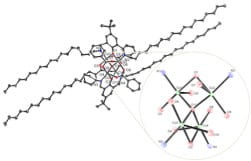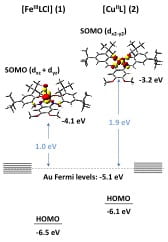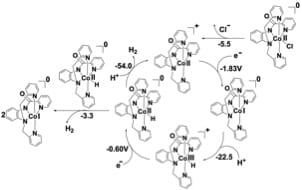I. Redox-responsive amphiphiles for current rectification
A. Background and significance
Core concepts of the broadly defined field of molecular electronics give considerable importance to molecules able to display directional electron transfer. It is also a consensus that the use of films, rather than bulk solutions, will be a requirement for the eventual fabrication of devices for higher-end electronic applications. The Verani Group is focusing on a modular platform in which surface-deposited units display redox-active properties. Our hypothesis involves the idea that molecules that can exist in their resting “metal-only” ground state or in other ground state related to the presence of unpaired electrons at the metal or the ligand will prove useful in devices such as molecular rectifiers. Our approach incorporates an innovative bioinspired element that is the use of five-coordinating environments around the metal center similar to certain enzymes in nature that can handle fast redox changes and electron transport.
B. Accomplishments
Early on we established the value of archetypical modeling as a valid experimental tool for understanding the structural and electronic properties of waxy metallosurfactants. We then demonstrated that rigidity of the redox/amphiphilic ligand in cobalt(III) surfactants can lead to distinctive collapse mechanisms both at constant isothermal area and pressure. On another front, we demonstrated that multimetallic clusters can be incorporated into amphiphilic precursors and deposited as ordered Langmuir-Blodgett films, and examined the formation of patterned films at the air/water interface with copper(II) surfactants.

More recently we studied a series of five-coordinate iron(III) complexes surrounded by multiple phenolate groups and characterized the magnetic changes associated with several distinctive redox-triggered ground states. We associated such ground states with molecular orbital changes by means of experimental and theoretical evidence establishing the fundamentals for the use of such systems as film precursors for current rectification. This is an asymmetric flow of electric current. Rectifiers, such as vacuum tubes or solid-state diodes, enable current to flow in one direction while preventing reversibility. These five-coordinate iron complexes have been further functionalized into amphiphilic species and used as precursors for Langmuir-Blodgett films in devices that show the ability to rectify electric current via an asymmetric mechanism fundamental to the conversion of alternating into direct current.

II. Catalysts for water splitting
A. Background and significance
Solar-based water splitting is a non-trivial process considered essential to the nascent hydrogen economy. Known photocatalytic systems typically rely on (i) light-absorbing antennae, (ii) charge accumulation sites, and (iii) catalytic centers, all working in tandem. Achievements in each of these individual subsystems have generated intense interest, but the understanding of concerted interactions among multiple systems continues to pose a formidable task to water splitting. This is due to the multielectronic nature of the process and the potential formation of highly reactive undesired intermediates that yield incomplete conversion. The Verani group is investigating mono and multimetallic scaffolds, where transition metal ions are kept in close proximity, aiming to achieve a better understanding of the thermodynamics necessary to support water splitting mechanisms. Particular emphasis is given to the use of Earth-abundant modular systems capable of photo and electrocatalysis aiming to produce dihydrogen and dioxygen from water.
B. Accomplishments
The Verani Group is investigating a series of monometallic modules aiming at a better understanding of photo and electrocatalytic water splitting. We have recently described several cobalt-containing catalysts based on oxime, phenolate, and pyridine-rich ligands capable of efficient water reduction.
We are also investigating the use of other Earth-abundant metals such as manganese, iron, nickel, and copper. Some of these catalytic species can be modified to become surface-active and to act as water oxidation catalysts. We focus on catalyst design and on the understanding of the mechanisms involved in such processes.

